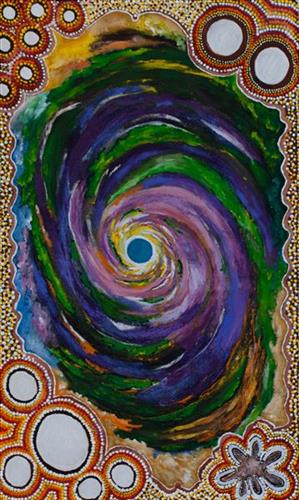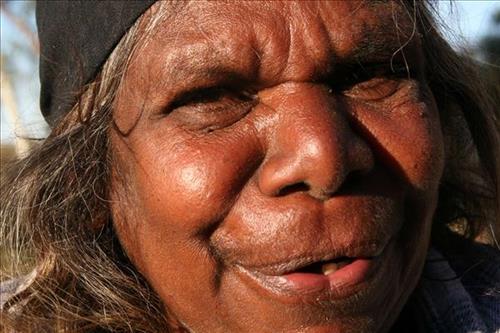111581988543
Kurrunpa Pukurlpa (Spirit Happy)
“This one here is just like when you got a lot of stress and worries. Make your mind think of a lot of things. In this painting I put not bad colours, good colours to help fight those things in your mind. These two (points to white circles bottom right) maparn wantis (spiritual, magic ladies) they landed at Wantili they would put out a sort of radar so the Seven Sisters would know where to go. They spiritual ladies, like GPS they help find your way. This one (points to top right) is Seven Sisters. Over there (top left) Southern Cross, maparn girls, medicine girls. Here (bottom left) is the ngurra (home, country, camp) for wantis. When they dance around the ngurra, smooth it all out. All these create the minerals, the gold. The dotting colour Martu use these for lore.”
The term Jukurrpa is often translated in English as the ‘dreaming’, or ‘dreamtime’. It refers generally to the period in which the world was created by ancestral beings, who assumed both human and nonhuman forms. These beings shaped what had been a formless landscape; creating waters, plants, animals, and people. At the same time they provided cultural protocols for the people they created, as well as rules for interacting with the natural environment. At their journey’s end, the ancestral beings transformed themselves into important waters, hills, rocks, and even constellations.
Minyipuru, or Jakulyukulyu (Seven Sisters) is a central Jukurrpa narrative for Martu, Ngaanyatjarra, Pitjantjatjara and Yankunytjatjara people that is associated with the seasonal Pleiades star constellation. Relayed in song, dance, stories and paintings, Minyipuru serves as a creation narrative, a source of information relating to the physical properties of the land, and an embodiment of Aboriginal cultural laws. When Martumili Artists was established in 2005, this was the first Jukurrpa story the artists agreed to paint for a broader public.
Beginning in Roebourne on the west coast of Western Australia, the story morphs in its movement eastward across the land, following a group of women as they walk, dance, and even fly from waterhole to waterhole. As they travel the women camp, sing, wash, dance and gather food, leaving markers in the landscape and creating landforms that remain to this day, such as groupings of rocks and trees, grinding stones and seeds. During the entirety of their journey the women are pursued by a lustful old man, Yurla, although interactions with other animals, groups of men, and spirit beings are also chronicled.




